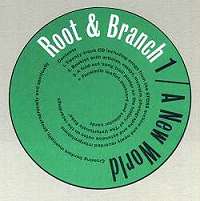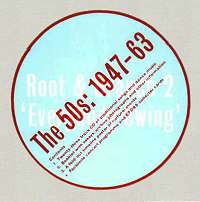Root & Branch
Review by Mark Gregory
Folk magazines have long interested me. When I lived in Albury in the 1960s I took out a subscription to Tradition and got the back issues of Gumsuckers Gazette thrown in. That collection has travelled around with me ever since. Browsing my bookshelf I find I have some stray issues of Northern Folk, Stringybark and Greenhide and Singabout. I have a few English Dance and Song and New City Songster issues but no Sings. I still have some of the song compilations that Singout! published. I also have odd magazines that just made one issue like Folksay from Melbourne and Folk View from Sydney. I have started to subscribe again to Singout!, now in its 50th year and occasionally including a CD strapped to the cover, I also subscribe to Ron Edward's great Australian Folklore Society Journal from the far north and Pioneer Performer from the depths of Wongawilli. Late last year I sent off a subscription to Root & Branch, a new magazine which this article is attempting to be all about.
A few months ago the first issue arrived. A sturdy cardboard package. Inside
was a feast of a magazine, a folder containing 11 separate items. 2 "Images
of Tradition" trading cards. A subscription form, a brochure about
the new CD issue of the Radio Ballads, a postcard with a photo of a poem
on a
toilet wall in Kent (a version of Died for Love called The Borstal Boy),
a brochure introducing the English Folk Dance & Song Society, a pamphlet
titled "Hints to Collectors of Folk Music", a form for the
purchase of folk CD specials, a fold out poster size page describing
the evolution
of "The Unfortunate Rake". Also contained in the folder were a
24 page magazine and a 20 track CD with in a folding cardboard case with
a photo
of a Revox A77 tape recorder.
 vol
1 Booklet Contents
vol
1 Booklet Contents
- Introduction: Crossing Borders: Vic Gammon
- On Collectors and Collecting: Mike Yates
- Swedes in Dakota: Andrew Cronshaw
- A.L.Lloyd in Australia: Dave Arthur
- Recording in Kentucky with Alan Lomax: Shirley Collins
The CD is subtitled A New World and the songs are described as "crossing boarders musically, geographically and spiritually". Songs that tell of the experience of people who have travelled in those ways. There are 3 versions of Van Diemanâs Land, a wonderful Wild Colonial Boy from Fred Whiting of Suffolk, Tom Dula, The Shores of Lough Bran, a Baptist preacher led Poor Pilgrim of Sorrow from Kentucky, a powerfully lonely Green Fields of Canada. The compilation says much about the folksong revival, the mixture of field recordings and revival singers, the embracing of material from a number of countries, the inclusion of hymn and music hall material recorded from traditional singers. In short a selection of the very broad range of material that the folk revival has borrowed from.
Root & Branch 2 came a couple of months later in its by now familiar folder. The same enticing bits and pieces. A reproduction of a 1951 London Jazz Club program for a Big Bill Broonzy "recital" a couple more trading cards, a fold-out timeline of the folk revival in Britain from 1947 to 1963. This issue is subtitled "Everybody Swing" and the CD has 23 tracks spanning the broad sweep of music from George Webbâs Dixilanders in London in 1947, The great Margaret Barry with her "She Moves Through the Fair", the calypso singer "Lord Kitchener", skiffle, a Christmas link up broadcast of Alan Lomax on the BBC, Irish music from London pubs, Jimmy Shand, Big Bill Broonzy.
 vol 2 Booklet Contents
vol 2 Booklet Contents
- Introduction The Fifties 1947-63: Reg Hall
- A New Society: Ron Smedley
- Topic: A People's Label: Bill Leader
- The BBC and Folk Music Broadcasting: E David Gregory
- Sons and Daughters of Africa: John Cowley
- Irish Music and Dance in London: Reg Hall
- Skiffle: The First Alternative Music: Billy Bragg
- Purists, Popularisers and Tolerators: the Clubs: Eric Winter
It's wonderful material and I just hope they can keep it up.
Root & Branch is a timely reminder in our current debates that the folk revival is a mixed bag. Those interested in folk song were usually influenced by more than just their own folk songs. Performers took what they admired from many sources. In many ways the folk revival took on an international as well as national character. Those who at various times tried to predict or direct its path were as likely as not to be proven wrong. I think the release of this kind of material indicates that the revival really had a life of its own, a life we are only beginning to sense or make much sense of. Not that such a notion is peculiar to EFDSS or its Root & Branch, indeed it seems to resonate well with ideas that are developing here with a growing interest in the history of the folk revival and the musical and political culture it evolved in. An interest in the effect of immigration on the revival, and an interest in rural dance bands like the Gay Charmers or the music portrayed in recent the documentary film and book Buried Country.
The mixture of field recordings and studio recordings is interesting too. Folk revival singers often imagine they sound reasonably like the informants whose material they have chosen to learn. What is obvious here is how much closer the performance of an informant from Suffolk is to Simon Macdonald in Victoria than to any revival singer from either country. You might argue that since the Suffolk singer, Fred Whiting, spent 7 years in NSW that explains the similarity. I think it's a style of performance the revival has yet to capture. Have we revived what we set out to revive?
Root & Branch be ordered from the EFDSS (English Folk Dance & Song Society) web site at: http://www.efdss.org/ for £32.00 for 2 issues.